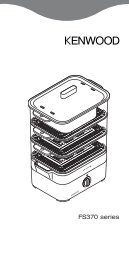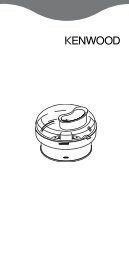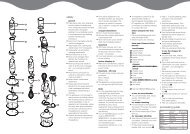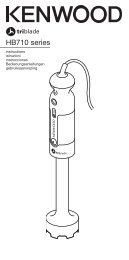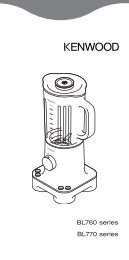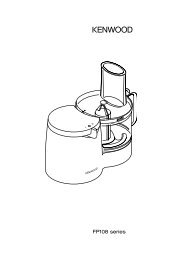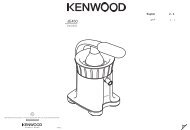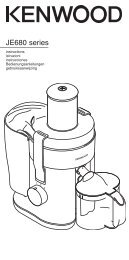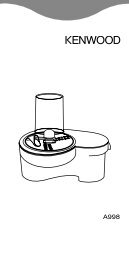Create successful ePaper yourself
Turn your PDF publications into a flip-book with our unique Google optimized e-Paper software.
PATISSIER MX270 SERIES & KM270 SERIES<br />
the mixer<br />
the mixing tools and some of their uses<br />
beater ● For making cakes, biscuits, pastry, icing, fillings, éclairs and mashed potato.<br />
whisk ● For eggs, cream, batters, fatless sponges, meringues, cheesecakes,<br />
mousses, soufflés. Don’t use the whisk for heavy mixtures (eg<br />
creaming fat and sugar) - you could damage it.<br />
dough hook ● For yeast mixtures.<br />
to insert a tool<br />
to remove a tool<br />
to use your mixer<br />
1 Push up on the head release lever at the back of the appliance and<br />
at the same time lift the head until it locks in the raised position.<br />
2 Line the pin on the shaft with the slot on the inside of the tool, push<br />
up and turn clockwise to lock .<br />
3 Fit the bowl onto the base, press down and turn clockwise to lock .<br />
4 Push up on the head release lever and at the same time lower the mixer head<br />
.<br />
5 Switch on and move the speed switch to the desired setting .<br />
6 Push up, turn anti-clockwise and pull off.<br />
<br />
hints ● Switch off and scrape the bowl with a spatula when necessary.<br />
● Eggs at room temperature are best for whisking.<br />
● Before whisking egg whites, make sure there’s no grease or egg yolk on<br />
the whisk or bowl.<br />
● Use cold ingredients for pastry unless your recipe states otherwise.<br />
● When creaming fat and sugar for cake mixes, always use the fat at room<br />
temperature or soften it first.<br />
● Your mixer has been fitted with ‘soft start’ feature to minimise spillage.<br />
However if the machine is switched on with a heavy mixture in the bowl<br />
such as bread dough, you may notice that the mixer takes a few seconds<br />
to reach the selected speed.<br />
<br />
points for bread making<br />
important ● Never exceed the maximum capacities below - you will overload the machine.<br />
● To protect the life of the machine always allow a rest of 20 minutes between<br />
loads.<br />
● Some movement of the mixer head is normal. If you hear the machine<br />
labouring, switch off, remove half the dough and do each half separately.<br />
● The ingredients mix best if you put the liquid in first.<br />
● At intervals stop the machine and scrape the mixture off the dough hook.<br />
● Different batches of flour vary considerably in the quantities of liquid<br />
required and the stickiness of the dough can have a marked effect on<br />
the load imposed on the machine. You are advised to keep the machine<br />
under observation whilst the dough is being mixed; the operation should<br />
take no longer than 5 minutes.<br />
<br />
speed switch<br />
These are a guide only and will vary depending upon the quantity of mix<br />
in the bowl and the ingredient being mixed.<br />
beater ● creaming fat and sugar start on 2, gradually increasing to 12.<br />
● beating eggs into creamed mixtures 6 - 12.<br />
● folding in flour, fruit etc 2 - 4.<br />
● all in one cakes start on speed 2, gradually increase to 12.<br />
● rubbing fat into flour 2 - 4.<br />
whisk ● Gradually increase to 12.<br />
dough hook ● Start on 2, increasing to 4 or 6.<br />
maximum capacities<br />
shortcrust pastry ● 500g flour<br />
fruit cake mix ● 2 Kg total mix<br />
stiff bread dough ● 600g flour<br />
soft bread dough ● 650g flour<br />
egg whites ● 12 (A minimum of 2 medium size egg whites can be whisked).<br />
2



